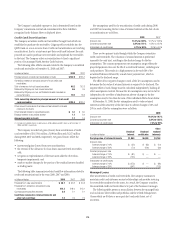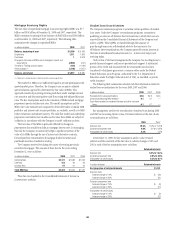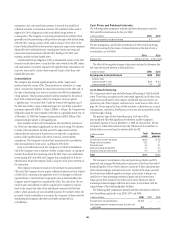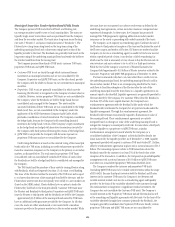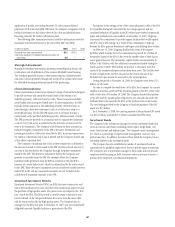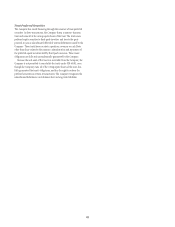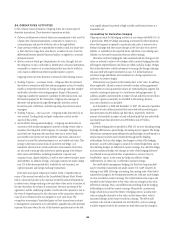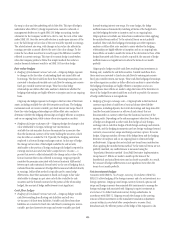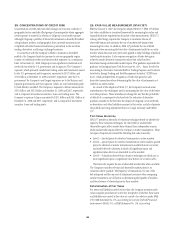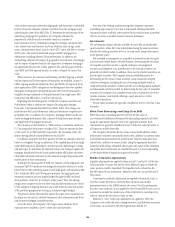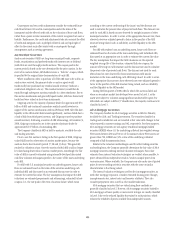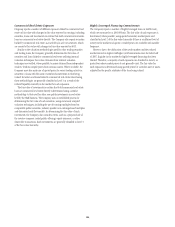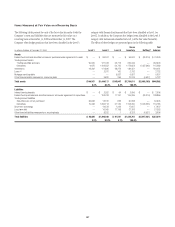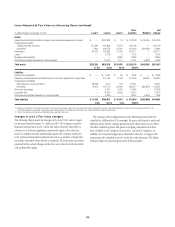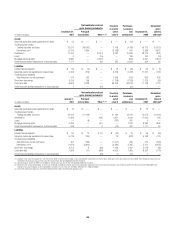Citibank 2008 Annual Report Download - page 195
Download and view the complete annual report
Please find page 195 of the 2008 Citibank annual report below. You can navigate through the pages in the report by either clicking on the pages listed below, or by using the keyword search tool below to find specific information within the annual report.24. DERIVATIVES ACTIVITIES
In the ordinary course of business, Citigroup enters into various types of
derivative transactions. These derivative transactions include:
•Futures and forward contracts which are commitments to buy or sell at
a future date a financial instrument, commodity or currency at a
contracted price and may be settled in cash or through delivery.
•Swap contracts which are commitments to settle in cash at a future date
or dates that may range from a few days to a number of years, based on
differentials between specified financial indices, as applied to a notional
principal amount.
•Option contracts which give the purchaser, for a fee, the right, but not
the obligation, to buy or sell within a limited time a financial instrument,
commodity or currency at a contracted price that may also be settled in
cash, based on differentials between specified indices or prices.
Citigroup enters into these derivative contracts for the following reasons:
•Trading Purposes—Customer Needs – Citigroup offers its customers
derivatives in connection with their risk-management actions to transfer,
modify or reduce their interest rate, foreign exchange and other market/
credit risks or for their own trading purposes. As part of this process,
Citigroup considers the customers’ suitability for the risk involved, and
the business purpose for the transaction. Citigroup also manages its
derivative-risk positions through offsetting trade activities, controls
focused on price verification, and daily reporting of positions to senior
managers.
•Trading Purposes—Own Account – Citigroup trades derivatives for its
own account. Trading limits and price verification controls are key
aspects of this activity.
•Asset/Liability Management Hedging—Citigroup uses derivatives in
connection with its risk-management activities to hedge certain risks or
reposition the risk profile of the Company. For example, Citigroup may
issue fixed-rate long-term debt and then enter into a receive-fixed,
pay-variable-rate interest rate swap with the same tenor and notional
amount to convert the interest payments to a net variable-rate basis. This
strategy is the most common form of an interest rate hedge, as it
minimizes interest cost in certain yield curve environments. Derivatives
are also used to manage risks inherent in specific groups of on-balance
sheet assets and liabilities, including investments, corporate and
consumer loans, deposit liabilities, as well as other interest-sensitive assets
and liabilities. In addition, foreign- exchange contracts are used to hedge
non-U.S. dollar denominated debt, available-for-sale securities, net
capital exposures and foreign-exchange transactions.
Derivatives may expose Citigroup to market, credit or liquidity risks in
excess of the amounts recorded on the Consolidated Balance Sheet. Market
risk on a derivative product is the exposure created by potential fluctuations
in interest rates, foreign-exchange rates and other values and is a function of
the type of product, the volume of transactions, the tenor and terms of the
agreement, and the underlying volatility. Credit risk is the exposure to loss in
the event of nonperformance by the other party to the transaction where the
value of any collateral held is not adequate to cover such losses. The
recognition in earnings of unrealized gains on these transactions is subject
to management’s assessment as to collectibility. Liquidity risk is the potential
exposure that arises when the size of the derivative position may not be able
to be rapidly adjusted in periods of high volatility and financial stress at a
reasonable cost.
Accounting for Derivative Hedging
Citigroup accounts for its hedging activities in accordance with SFAS 133. As
a general rule, SFAS 133 hedge accounting is permitted for those situations
where the Company is exposed to a particular risk, such as interest-rate or
foreign-exchange risk, that causes changes in the fair value of an asset or
liability, or variability in the expected future cash flows of an existing asset,
liability or a forecasted transaction that may affect earnings.
Derivative contracts hedging the risks associated with the changes in fair
value are referred to as fair value hedges, while contracts hedging the risks
affecting the expected future cash flows are called cash flow hedges. Hedges
that utilize derivatives or debt instruments to manage the foreign exchange
risk associated with equity investments in non-U.S. dollar functional
currency foreign subsidiaries (net investment in a foreign operation) are
called net investment hedges.
All derivatives are reported on the balance sheet at fair value. In addition,
where applicable, all such contracts covered by master netting agreements
are reported net. Gross positive fair values are netted with gross negative fair
values by counterparty pursuant to a valid master netting agreement. In
addition, payables and receivables in respect of cash collateral received from
or paid to a given counterparty are included in this netting. However,
non-cash collateral is not included.
As of December 31, 2008 and December 31, 2007, the amount of payables
in respect of cash collateral received that was netted with unrealized gains
from derivatives was $52 billion and $26 billion, respectively, while the
amount of receivables in respect of cash collateral paid that was netted with
unrealized losses from derivatives was $58 billion and $37 billion,
respectively.
If certain hedging criteria specified in SFAS 133 are met, including testing
for hedge effectiveness, special hedge accounting may be applied. The hedge-
effectiveness assessment methodologies for similar hedges are performed in a
similar manner and are used consistently throughout the hedging
relationships. For fair value hedges, the changes in value of the hedging
derivative, as well as the changes in value of the related hedged item, due to
the risk being hedged, are reflected in current earnings. For cash flow hedges
and net investment hedges, the changes in value of the hedging derivative
are reflected in Accumulated other comprehensive income (loss) in
Stockholders’ equity, to the extent the hedge was effective. Hedge
ineffectiveness, in either case, is reflected in current earnings.
For asset/liability management hedging, the fixed-rate long-term debt
may be recorded at amortized cost under current U.S. GAAP. However, by
electing to use SFAS 133 hedge accounting, the carrying value of the debt is
adjusted for changes in the benchmark interest rate, with any such changes
in value recorded in current earnings. The related interest-rate swap is also
recorded on the balance sheet at fair value, with any changes in fair value
reflected in earnings. Thus, any ineffectiveness resulting from the hedging
relationship is recorded in current earnings. Alternatively, an economic
hedge, which does not meet the SFAS 133 hedging criteria, would involve
only recording the derivative at fair value on the balance sheet, with its
associated changes in fair value recorded in earnings. The debt would
continue to be carried at amortized cost and, therefore, current earnings
would be impacted only by the interest rate shifts that cause the change in
189


